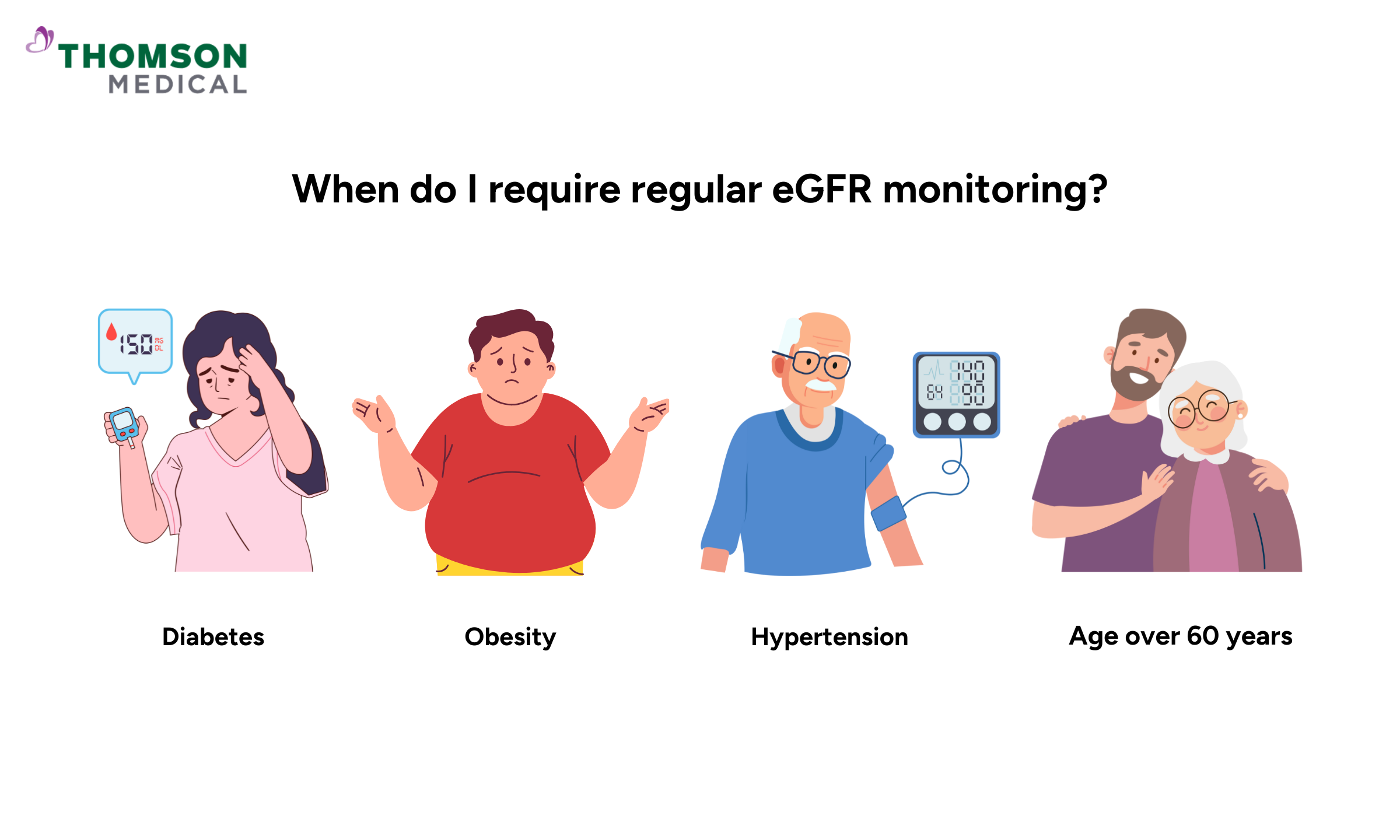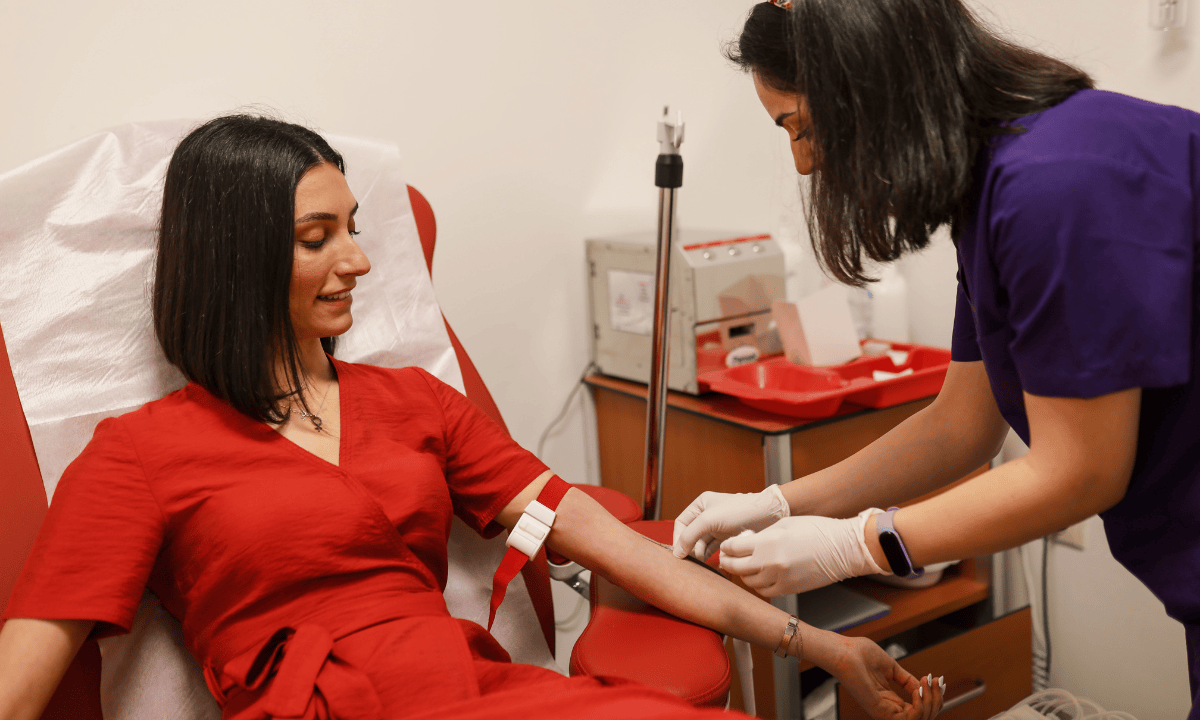What is the estimated glomerular filtration rate (eGFR)?
eGFR is a blood test to check kidney health by evaluating how well the kidneys filter toxins (waste products) from the blood. This test calculates how much blood is filtered per minute based on several factors, including age, gender, body size, and the concentration of waste products like creatinine in the blood.
Because this blood test assesses the filtration rate of the kidneys, it can also detect kidney disease early, even before symptoms appear. As such, healthcare providers can start treatment sooner, which helps slow the progression of kidney damage and prevent complications.
When do I need an eGFR test?
An eGFR test is usually performed as part of a routine blood test to monitor overall health, including kidney function. However, your healthcare provider may specifically order an eGFR test if you have a medical condition that increases your risk of chronic kidney disease (CKD).

Here are some risk factors for kidney disease that require regular eGFR monitoring, including:
Diabetes mellitus
Kidney stones
Overweight
Hypertension (high blood pressure)
Heart disease (such as coronary artery disease)
Family history of kidney disease
Age over 60 years
Congenital birth defects affecting kidney function
When should I call the doctor?
If you are at risk for kidney disease or have been diagnosed with it, contact your healthcare provider if you experience any of the following symptoms:
Frequent urination, blood in urine, or foamy urine
Persistent itchy skin
Puffiness around the eyes
Unexplained fatigue
Muscle cramps
Nausea or vomiting
Shortness of breath
Swollen hands, legs, or feet
Sudden loss of appetite
If you are experiencing any of these symptoms, request an appointment with Thomson Medical, where our specialists can assist with further diagnosis, including an eGFR blood test to identify the underlying causes of your medical conditions.
What to expect during the procedure
eGFR is a simple blood test, which only requires taking a blood sample from your vein to measure the creatinine concentration in it. However, you need to make the following preparations before your blood sample is taken:
Avoid eating solid food the night before the test.
Refrain from consuming cooked meat the day before.
Temporarily stop taking supplements for building muscle mass, such as creatine.
This preparation is necessary, as creatinine levels in the blood can be affected by these factors, which in turn influence eGFR readings. Creatinine itself is a waste product produced by the normal breakdown of muscle tissue and the use of energy by the muscles.
In healthy kidneys, creatinine in the blood will be filtered and discharged through urine. However, when kidney function declines, creatinine gradually accumulates in the blood.
What is a normal eGFR for my age?
To calculate your eGFR level, your healthcare provider will consider your creatinine levels along with factors such as height, gender, and body size. The eGFR is measured in millilitres of cleansed blood per minute per body surface area (a measurement that reads mL/min/1.73 m²).
The normal eGFR range varies with age; adults under 60 typically have a normal value of 90 mL/min/1.73 m² or higher.
Here are the normal average eGFR values for different age groups:
20 to 29 years old: 116 mL/min/1.73 m²
30-39 years old: 107 mL/min/1.73 m²
40-49 years old: 99 mL/min/1.73 m²
50-59 years old: 93 mL/min/1.73 m²
60-69 years old: 85 mL/min/1.73 m²
70+ years old: 75 mL/min/1.73 m²
This normal range generally decreases along with ageing and loss of muscle mass, even in people without kidney disease. A higher eGFR level indicates excellent kidney health, while a lower estimated glomerular filtration rate can be a sign of kidney disease or kidney failure.
What do the results mean?
The eGFR test tells you what stage your kidneys are in right now. Based on the test results, there are five stages that show how damaged and dysfunctional the kidney is. Here are the five stages of eGFR, which include:
Stage 1 (eGFR 90 or higher)
The first stage is the normal kidney condition for most healthy adults, where your kidneys are still working normally.
Stage 2 (eGFR between 60 and 89)
There has been a slight reduction in kidney function due to mild kidney damage, but overall, the kidney still functions well.
Stage 3 (eGFR between 30 and 59)
At this stage, kidney function has been moderately impaired, along with an increased risk of chronic kidney disease and cardiovascular disease. This stage is also divided into two parts, which are:
Stage 3a: eGFR 45–59 mL/min/1.73 m²
Stage 3b: eGFR 30–44 mL/min/1.73 m²
Stage 4 (eGFR between 15-29)
At this stage, the kidneys are severely damaged, with poor kidney function leading to a significant buildup of waste products in the blood.
Stage 5 (eGFR less than 15)
This level is the most severe stage, where the kidneys have lost almost all of their function and are in danger of kidney failure.
This condition can be life-threatening if left untreated and requires dialysis, a machine to filter toxins from your blood, or a kidney transplant to ensure blood filtration.
If your eGFR levels are lower than 60 mL/min/1.73 m2 for more than 3 months, don't hesitate to consult a doctor. Request an appointment with Thomson Medical for recommendations based on your medical conditions and further evaluation.
Follow-up tests after eGFR
If your eGFR level falls below the normal range, additional tests may be performed to diagnose the exact medical condition. Here are some follow-up tests after eGFR that may be performed, including:
Creatinine clearance, which measures the creatinine levels in both urine and blood for a more precise assessment.
Urinalysis, a medical test that checks for the presence of albumin (a type of protein) and blood in the urine, which is an early sign of kidney disease.
Imaging tests such as ultrasound or CT scans identify medical conditions like kidney stones or cancer.
Kidney biopsy, which directly examines kidney tissue to determine the specific type and severity of kidney disease.
Are there any risks to the test?
Since the eFGR procedure only requires your blood to measure the creatinine levels, it is a fairly low-risk blood test. However, since it includes taking blood directly from the vein, there are a few minor discomforts that you may experience, such as:
Slight bruising, swelling, or soreness at the punctured site.
Slight pain or discomfort around the punctured area.
A slight sting during the needle insertion or removal.
Dizziness due to the withdrawal of blood.

FAQ
What is the normal level of eGFR?
In healthy adults under 60 years old, a normal eGFR is around 90 mL/min/1.73 m² or higher. However, as eGFR naturally decreases with age, you may have a low eGFR despite having no risk factors or being diagnosed with kidney disease.
What foods should I avoid with a low eGFR?
If your eGFR result is lower than normal, it indicates a decreased ability of the kidneys to filter waste products from the blood. Therefore, it is important to follow a diet that does not burden the kidneys and avoid foods that are high in sodium, potassium, and phosphorus.
Here are some foods that you should avoid if your eGFR result is low:
Any fast food items.
Any instant or premade foods.
Processed meats, including corned beef, sausage, or beef jerky.
Fruits, including bananas, avocados, and oranges.
Vegetables, such as spinach, tomatoes, potatoes, and sweet potatoes.
Cow's milk and dairy products.
Any pickled or cured food.
What does it mean when eGFR is low?
A low eGFR result is a sign of kidney disease, which affects the effectiveness of the kidneys to filter out toxins in the blood. If your eGFR falls below 60 mL/min/1.73 m² for more than three months, it may indicate moderate to severe kidney dysfunction that needs immediate medical attention.
What is a suitable eGFR for my age?
The normal eGFR varies with age and generally decreases as we grow older. In adults under 60 years old, a normal eGFR is around 90 mL/min/1.73 m² or higher. Here are the normal average eGFR values for different age groups:
20 to 29 years old: 116 mL/min/1.73 m²
30-39 years old: 107 mL/min/1.73 m²
40-49 years old: 99 mL/min/1.73 m²
50-59 years old: 93 mL/min/1.73 m²
60-69 years old: 85 mL/min/1.73 m²
70+ years old: 75 mL/min/1.73 m²
Can I improve my eGFR score?
If you want to improve your eGFR score, one way to do so is by adopting a healthier lifestyle, which includes:
Maintain your blood pressure and blood sugar level within the normal range.
Implementing a low sodium, potassium, and phosphorus diet.
Drink enough water daily.
Maintain a healthy weight by exercising regularly.
Quit smoking.
Reduce processed food consumption.
The information provided is intended for general guidance only and should not be considered medical advice. For personalised recommendations based on your medical conditions, request an appointment with Thomson Medical.
For more information, contact us:
Thomson Specialists Paragon (Health Screening)
- Mon - Fri: 8.30am - 5.30pm
- Sat: 8.30am - 12.30pm
Call: 6735 0300
Request a Health Screening